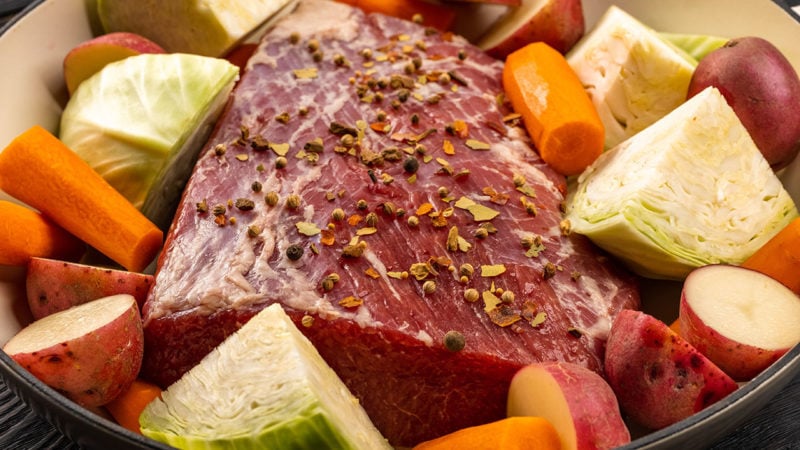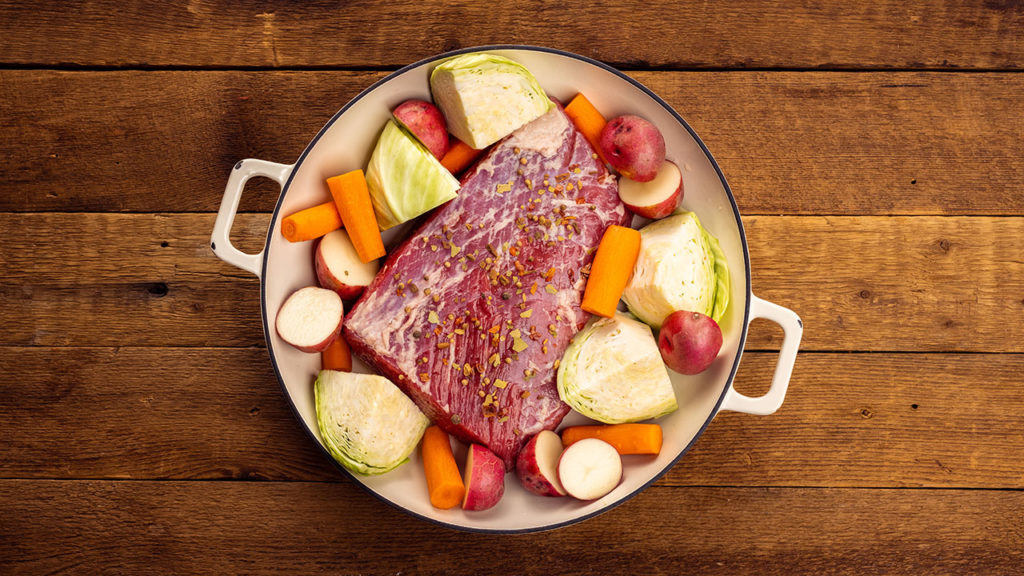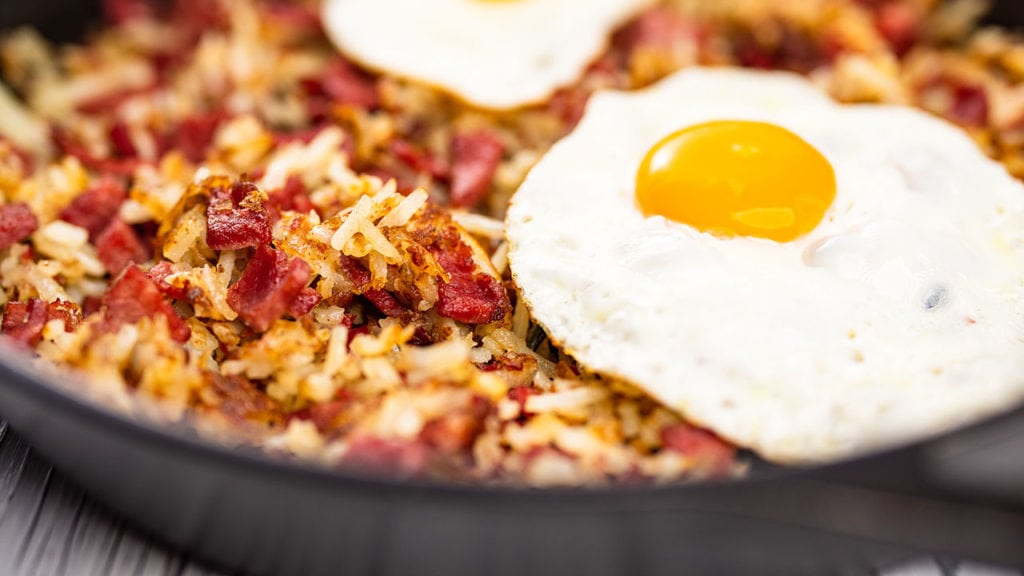Last Updated on January 28, 2025
Corned beef brisket is most often associated with St. Patrick’s Day—especially when combined with cabbage and potatoes. And although the traditional “boiled dinner” does trace its roots to Irish-Americans celebrating the patron saint of the Emerald Isle, the dish isn’t exactly traditional Irish fare. In fact, corned beef can be enjoyed any time of year and in an array of creative dishes.
Whether enjoying as part of a holiday boiled dinner, in a homemade breakfast hash, or cooked any other way, corned beef is a cut of beef that is packed with unique flavors.
We’ll go over a few things related to corned beef brisket in this guide, including:
- The history of the cut and why it is associated with St. Patrick’s Day celebrations.
- Everything you need to know about preparing and cooking corned beef brisket.
- A few of our favorite corned beef recipes.
The History of Corned Beef
Having a family tree that singularly branches back to Ireland, it’s fair to say that I’ve had my fair share of corned beef over the years. Digging into some background on the dish, it’s fascinating to learn that the current popularity of a brisket-centric boiled dinner as a featured component of St. Patrick’s Day festivities also does not lead back to Ireland. In fact, the traditional dish for celebratory occasions for the Irish was bacon or boiled pork.
Like many distinctly American foods, the story of corned beef and cabbage is influenced heavily by colonization and immigration.
Corned beef itself—a cut of beef brisket that has been salt-cured—is influenced by Eastern European brining techniques that were used to tenderize cuts of beef. These techniques were not in favor among the more well-to-do citizens of Europe and then the colonies in North America. The modifier “corned” has nothing to do with the maize discovered in the Americas. It’s actually related to the large salt pieces, which were similar in size and shape to corn kernels. The large salt pieces were used to, in essence, pickle the brisket. Eventually, the Irish became experts at producing corned beef, although they rarely enjoyed the dish themselves, shipping it to England, France, or the Americas.
Corned beef became a staple of many immigrant foodways—it is still a prominent sandwich filler at Jewish delicatessens. It was also adopted by the Irish immigrants as the affordable alternative to the traditional St. Patrick’s Day meal of pork.
There is some irony in beef brisket evolution to its central role in the celebrations of Irish immigrants and their descendants. Cattle—and therefore beef—often held a sacred position in Irish folklore and mythology. Eventually, however, cattle were transformed from a work animal to a food export by the colonizing, beef-loving English.
Cooking Corned Beef
Corned beef brisket can be cooked a number of ways. However, the “boiled dinner” is the one most often associated with the cut. As the name boiled dinner suggests, the beef is cooked in a pot of hot water with an accompaniment of various vegetables: Most often root veggies like carrots, potatoes, and radishes, but also cabbage as well.
The Corned Beef Spice Packet
Most corned beef comes with a packet of the traditional boiled dinner spices—ButcherBox’s own corned beef comes with the spice package, for instance. The packet usually includes some combination of spices, including mustard seed, coriander, fennel, dill seed, peppercorn, crushed red pepper, anise, and crushed bay leaf. ButcherBox’s spice packet includes mustard seed, dill seed, coriander, cracked bay leaf, crushed chiles, and fennel. The packet gets added to the boiled dinner or coats the corned beef brisket if cooked in the oven.
Cooking Methods for Corned Beef
We recommend cooking the corned beef in an oven preheated to 400°F. You can cook it in a baking pan, fat-side up and covered with the spices. Be sure to add one inch of water to the pan. Cover with foil and cook for 50 minutes per pound, until the internal temperature reaches 170°F.
You can also cook it in a slow cooker or large pot on the stovetop with potatoes, onions, carrots, and cabbage—the traditional boiled dinner. In a pot, add the spices and cover with water, and bring everything to a boil. Then lower to a medium simmer, cover the pot, and simmer for one-and-a-half hours. Finally, remove from heat and leave in the pot covered for 30 more minutes. In a slow cooker, cook between four-to-five hours on high, or six-to-eight hours on low. Make sure to defrost the corned beef before cooking.
Corned Beef Recipes
Here are a few different ways to cook corned beef and to use leftovers in other dishes. Enjoy!
Easy Overnight Corned Beef Brisket
Don’t have a corned beef brisket but in the mood for it? Grab a brisket and brine it overnight. Follow this recipe from Chef Yankel for your own homemade corned beef.
Corned Beef Hash
Take your leftover corned beef and incorporate it into the best breakfast you can possibly make: Homemade corned beef hash. Combine your leftover corned beef with potatoes, onions, and even carrots in a skillet. Brown the ingredients, add some spices, and cover with a few eggs. It’s even better if you replace the potatoes with sweet potatoes. Check out this recipe for inspiration.
Dennis Keohane is a writer, editor, and former Editorial Director for ButcherBox with a passion for storytelling and food. Combining his love for high-quality ingredients with engaging narratives, he crafts content that inspires home cooks to explore new flavors, techniques, and the joy of cooking.






